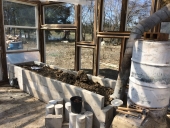This one doesn't count as an invention, but I have never heard of steam being used in this way. I said steam. Get over it. There will be two blow out valves or six if you like. Nothing is going to blow up, especially since this is currently a thought experiment.

This
thread explores something similar. ---
https://permies.com/t/33284/energy/Steam-Powered-Eductor-Energy-System#260242
-------------------------------------------------------------------------------------------------
My property will eventually utilize several hot tubs. I get old tubs for free, so I want to roast in them (or is it simmer), raise fingerling fish in them and store
irrigation water in them. I want at least one inside a
greenhouse spa for winter use, one on
land in the forest near the
pond and one floating in the
pond as described here. ---
https://permies.com/t/32481/rocket-stoves/Dale-hot-tub-swimming-dock
The idea is to use a steam powered jet pump to suck water from a shallow well and pour it directly into the hot tub. Normally this sort of pump is not used since it is inefficient. Much more
energy goes into heating the water than to lifting it. This is why steam jets are acceptable as a means of adding water to a boiler. Energy will be expended to heat the water anyway, so the heat is not lost. The same logic holds true when
wood is burned to pump water into a wood heated tub. --- This might also be viable for use in aquaponic systems where the water is to be heated.
I envision a
rocket stove with a pressure vessel mounted at the top of the riser. After losing some heat to the boiler, the gasses would proceed to a flue that runs through the tub bottom and up the inside of the tub. It would need to be shrouded to prevent burning the occupants as is done with snorkel stoves.
Suppose we need 50 psi to pump water to the hot tub. We use a tank rated for 150. We set it up so that whenever it reaches 50 or 60 psi, steam would be released into an insulated pipe that leads to the pump. A blow out valve set for 80 psi would dump steam into a steel earth tube,
should the primary pressure relief ever fail.
------------------------------------------------------------------------------------------------
Operation --- This is a batch system for both the hot tub and the pressure vessel. Some management would be needed. In order to get steam in a short amount of time, we'd start with only a few inches of water in the bottom of the vessel. This first batch of boiler water would send
enough water to the tub to cover the portion of the flue near the fiberglass at the bottom of the hot tub. After this is accomplished, trip a pressure release and fill the vessel with enough clean water to produce all of the steam required to fill the tub. The variables on vessel size and fire configuration are endless. It would make sense to use a vessel that holds more than enough water to produce the required steam to fill the tub.
- Once the tub is on it's way to being filled, everything works automatically except for the feeding of the fire. The vessel will send a burst of steam to the pump whenever it reaches adequate pressure. An ideal situation would see a vessel and fire sized so that flow is continuous but never gets so hot that steam is dumped down the drain by the blow out valve. A check valve prevents water from running down the pipe, back into the well whenever the pressure drops enough for the valve to close. The outdoors is a perfect spot to experiment with automatic feeding devices.
- Sterling engines were once used to draw water from
wells and rivers to elevated storage. The operators knew that a given amount of
firewood would equal a certain quantity pumped. The same should be possible here. The Sterling made no use of waste heat except when they were installed in a barn or other heated structure and they were thus only about 10% efficient. Since the water for the tub absorbs all of the steam that runs the pump, this should be much more efficient. Boiler design and insulation of the boiler and jet pipe are required to ensure that we heat water, not the outside air.
- At some point, the tub will be filled. If the steam is produced from a rocket separate from the one that heats the tub, it could be simply allowed to run out of fuel. Steam pressure could also be used to power tub jets. For this we might want to use a pressure relief valve set at 10 psi. The steam would need to be introduced at sufficient distance to allow it to completely condense within the stream. I'll leave this for others to mull over.
- I believe that a situation like mine is ideal for this type of tub heating. I have a clean water source that is close to the surface in an area surrounded by
trees that need constant thinning. There is no electricity near the site. The tub site is above other areas where irrigation water is desired. After each use, the tub water will be gravity fed to where it is needed.
This type of pump could operate in many off grid, camping type situations. Even in spots where it's impossible to haul a hot tub, a light pond liner could be used. Remote campgrounds that have many people showering each morning and night, could use a steam powered jet pump to elevate and heat the water.
-----------------------------------------------------------------------------------------------
Please chime in if you have any insights as to how to better accomplish this using steam and a jet pump or something similar that uses firewood as it's only fuel. I'm fully aware of photovoltaic technology and the many other ways to raise and heat water.





